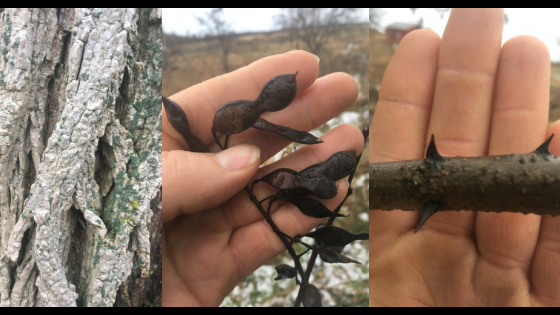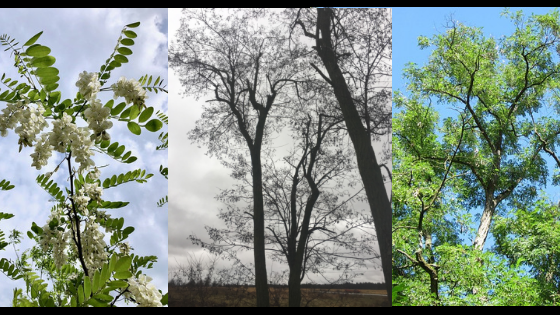Black Locust, its homestead uses and culture
Robinia pseudoacacia, commonly known as black locust, is a medium-sized hardwood deciduous tree native to the southeastern United States, but it has been widely planted and naturalized elsewhere in temperate North America, Europe, Southern Africa and Asia. Being a very useful farmstead resource, Black Locust has been cultivated and is currently found throughout North America, in all the lower 48 states, eastern Canada, and British Columbia.
Description
Black locust reaches a mature height of 40–100 feet and a diameter of 2–4 feet. It is an upright tree with a straight trunk which grows rough and scraggly with age. It has dark blue-green compound leaves that turn pale yellow in the fall. This tree also has thorns which are more prominent on younger trees and less prominent on mature trees. Flowers are creamy white with a yellow splotch in the center. They open in May or June for 7–10 days, after the leaves have developed. The Black Locust is a legume and fixes nitrogen from the atmosphere. It prefers dry to moist soil and tolerates a soil pH range of 4.6 to 8.2. It is pioneer species that requires full sunlight and will not tolerate shade. It reproduces both by seed (found inside a brown pea like pod), suckers, and runners from from the roots. It can be propagated from root cuttings. It grows extremely fast, 3-4 ft a year. It is now considered an “invasive” in some locations.

Homestead Uses
Because it grows very fast (3-4 ft a season) it makes great windbreaks, shelterbelts, and shade and shelter for animals in silvopasture grazing systems.
The wood is highly rot resistant and makes excellent fence posts. It is not uncommon for locust posts to last 50 years or more! Just be sure to use short fence staples because locust posts are extremely hard.
The wood also makes excellent firewood. It is one of the highest BTU rated woods you can burn. Also, these fast growing trees when cut down will sprout anew from the stump using the existing root system to grow even faster than the they did the first time.
Honey production! The flowers are important sources of food for honeybees and when they are in bloom they are just teeming with bees. Black Locust honey is widely sought after.
It can be used as a nitrogen support crop for other species. Black Walnut producers have seen good results using it as nurse tree in walnut plantings.
In Romania the flowers are sometimes used to produce a sweet and perfumed jelly, much like how we make violet jelly here in the north east.
Because it is fast growing and has a vast root system, Black Locust is also used for erosion control.
Possible ruminant feed source with some important caveats. Black Locust leaves and bark are listed as toxic. The leaves however have been reported to be eaten in small amounts by beef cattle who seem to self limit their consumption to below the level that would make them sick. The leaves have a similar nutrition analysis as alfalfa. Horses should never be allowed to consume Black Locust because they have a much lower tolerance for the toxin. Horses that consume the plant show signs of anorexia, depression, incontinence, colic, weakness, and cardiac arrhythmia. Symptoms usually occur about 1 hour following consumption, and immediate veterinary attention is required.
Summary
The Black Locust tree has many homestead and farmstead uses. It’s ability to fix nitrogen and grow fast, makes it a very attractive tree to plant. Whether you need a hedge or windbreak, firewood or fence posts, a nectar source for honeybees, or a fast way to control erosion; the Black Locust might be the answer.
An important tip for starting Black Locust seeds is to soak them for 24 hrs in hot water before planting.

Awesome! As my oaks decide to fall, I'll be replacing them with a bunch of other trees and black locust is definitely on the list. Heck, I may plant some anyways before then. Fifteen over story trees on half an acre leaves room for a couple ;)
They make great fence posts. In the spring when they are in full bloom, they are just alive with honeybees!
So four feet in a year, would that bee from seedling to a four foot tree, or do they take a long time to germinate?
Nice! Great overview info on one of my favorite trees.
Sounds like it could be a useful tree. You mention fence post, is it easy enough to work with as a furniture wood also?
Our coppiced black locust grows easy 2 meters a year for the new shoots. Older trees grow much slower unless you prune them. The hubby is planning a new locust forest so let's hope our couple of hundred seeds germinate all.
Posted using Partiko Android
You just planted 0.07 tree(s)!
Thanks to @nateonsteemit
We have planted already
5521.57 trees
out of 1,000,000
Let's save and restore Abongphen Highland Forest
in Cameroonian village Kedjom-Keku!
Plant trees with @treeplanter and get paid for it!
My Steem Power = 31804.20
Thanks a lot!
@martin.mikes coordinator of @kedjom-keku